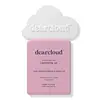What's inside
What's inside
 Key Ingredients
Key Ingredients

No key ingredients
 Benefits
Benefits

 Concerns
Concerns

 Ingredients Side-by-side
Ingredients Side-by-side

Water
Skin ConditioningC11-12 Isoparaffin
Skin ConditioningButylene Glycol
HumectantCucumis Sativus Fruit Extract
EmollientTriticum Vulgare Germ Extract
Skin ConditioningSqualane
EmollientAloe Barbadensis Leaf Extract
EmollientHordeum Vulgare Extract
EmollientSimmondsia Chinensis Seed Oil
EmollientAcrylates/C10-30 Alkyl Acrylate Crosspolymer
Emulsion StabilisingPEG-8 Dilaurate
EmulsifyingParfum
MaskingTromethamine
BufferingPhenoxyethanol
PreservativeCI 61570
Cosmetic ColorantCI 19140
Cosmetic ColorantWater, C11-12 Isoparaffin, Butylene Glycol, Cucumis Sativus Fruit Extract, Triticum Vulgare Germ Extract, Squalane, Aloe Barbadensis Leaf Extract, Hordeum Vulgare Extract, Simmondsia Chinensis Seed Oil, Acrylates/C10-30 Alkyl Acrylate Crosspolymer, PEG-8 Dilaurate, Parfum, Tromethamine, Phenoxyethanol, CI 61570, CI 19140
Helianthus Annuus Seed Oil
EmollientOlea Europaea Fruit Oil
MaskingPrunus Amygdalus Dulcis Oil
Skin ConditioningPolyglyceryl-2 Sesquioleate
EmulsifyingPolyglyceryl-2 Caprate
EmulsifyingParfum
MaskingTocopheryl Acetate
AntioxidantVitis Vinifera Seed Oil
EmollientWater
Skin ConditioningButylene Glycol
HumectantCaprylic/Capric Triglyceride
MaskingDipropylene Glycol
Humectant1,2-Hexanediol
Skin ConditioningC12-15 Alkyl Benzoate
AntimicrobialGlycyrrhiza Glabra Root Extract
BleachingChamomilla Recutita Flower Extract
MaskingLavandula Angustifolia Flower Extract
CleansingCentella Asiatica Extract
CleansingBorago Officinalis Extract
EmollientCentaurea Cyanus Flower Extract
AstringentSalvia Sclarea Extract
AntiseborrhoeicHydrogenated Lecithin
EmulsifyingHyacinthus Orientalis Extract
Skin ConditioningOenothera Biennis Flower Extract
AstringentUlmus Davidiana Root Extract
Skin ConditioningPinus Palustris Leaf Extract
TonicPueraria Lobata Root Extract
HumectantGlycolipids
Skin ConditioningCamellia Sinensis Leaf Extract
AntimicrobialPolygonum Cuspidatum Root Extract
AntioxidantSodium Surfactin
CleansingEthylhexylglycerin
Skin ConditioningAsiaticoside
AntioxidantMadecassic Acid
Skin ConditioningAsiatic Acid
Skin ConditioningScutellaria Baicalensis Root Extract
AstringentRosmarinus Officinalis Leaf Extract
AntimicrobialHelianthus Annuus Seed Oil, Olea Europaea Fruit Oil, Prunus Amygdalus Dulcis Oil, Polyglyceryl-2 Sesquioleate, Polyglyceryl-2 Caprate, Parfum, Tocopheryl Acetate, Vitis Vinifera Seed Oil, Water, Butylene Glycol, Caprylic/Capric Triglyceride, Dipropylene Glycol, 1,2-Hexanediol, C12-15 Alkyl Benzoate, Glycyrrhiza Glabra Root Extract, Chamomilla Recutita Flower Extract, Lavandula Angustifolia Flower Extract, Centella Asiatica Extract, Borago Officinalis Extract, Centaurea Cyanus Flower Extract, Salvia Sclarea Extract, Hydrogenated Lecithin, Hyacinthus Orientalis Extract, Oenothera Biennis Flower Extract, Ulmus Davidiana Root Extract, Pinus Palustris Leaf Extract, Pueraria Lobata Root Extract, Glycolipids, Camellia Sinensis Leaf Extract, Polygonum Cuspidatum Root Extract, Sodium Surfactin, Ethylhexylglycerin, Asiaticoside, Madecassic Acid, Asiatic Acid, Scutellaria Baicalensis Root Extract, Rosmarinus Officinalis Leaf Extract
Ingredients Explained
These ingredients are found in both products.
Ingredients higher up in an ingredient list are typically present in a larger amount.
Butylene Glycol (or BG) is used within cosmetic products for a few different reasons:
Overall, Butylene Glycol is a safe and well-rounded ingredient that works well with other ingredients.
Though this ingredient works well with most skin types, some people with sensitive skin may experience a reaction such as allergic rashes, closed comedones, or itchiness.
Learn more about Butylene GlycolParfum is a catch-all term for an ingredient or more that is used to give a scent to products.
Also called "fragrance", this ingredient can be a blend of hundreds of chemicals or plant oils. This means every product with "fragrance" or "parfum" in the ingredients list is a different mixture.
For instance, Habanolide is a proprietary trade name for a specific aroma chemical. When used as a fragrance ingredient in cosmetics, most aroma chemicals fall under the broad labeling category of “FRAGRANCE” or “PARFUM” according to EU and US regulations.
The term 'parfum' or 'fragrance' is not regulated in many countries. In many cases, it is up to the brand to define this term.
For instance, many brands choose to label themselves as "fragrance-free" because they are not using synthetic fragrances. However, their products may still contain ingredients such as essential oils that are considered a fragrance by INCI standards.
One example is Calendula flower extract. Calendula is an essential oil that still imparts a scent or 'fragrance'.
Depending on the blend, the ingredients in the mixture can cause allergies and sensitivities on the skin. Some ingredients that are known EU allergens include linalool and citronellol.
Parfum can also be used to mask or cover an unpleasant scent.
The bottom line is: not all fragrances/parfum/ingredients are created equally. If you are worried about fragrances, we recommend taking a closer look at an ingredient. And of course, we always recommend speaking with a professional.
Learn more about ParfumWater. It's the most common cosmetic ingredient of all. You'll usually see it at the top of ingredient lists, meaning that it makes up the largest part of the product.
So why is it so popular? Water most often acts as a solvent - this means that it helps dissolve other ingredients into the formulation.
You'll also recognize water as that liquid we all need to stay alive. If you see this, drink a glass of water. Stay hydrated!
Learn more about Water